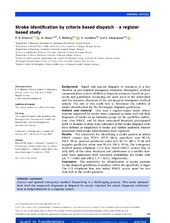| dc.contributor.author | Ellensen, Eirin Nybø | en_US |
| dc.contributor.author | Næss, Halvor | en_US |
| dc.contributor.author | Wisborg, Torben | en_US |
| dc.contributor.author | Hunskaar, Steinar | en_US |
| dc.contributor.author | Zakariassen, Erik | en_US |
| dc.date.accessioned | 2019-06-21T09:53:14Z | |
| dc.date.available | 2019-06-21T09:53:14Z | |
| dc.date.issued | 2018-01 | |
| dc.Published | Ellensen EN, Næss H, Wisborg TW, Hunskaar S, Zakariassen E. Stroke identification by criteria based dispatch - a register based study. Acta Anaesthesiologica Scandinavica. 2018;62(1):105-115 | eng |
| dc.identifier.issn | 1399-6576 | |
| dc.identifier.issn | 0001-5172 | |
| dc.identifier.uri | https://hdl.handle.net/1956/20334 | |
| dc.description.abstract | Background: Rapid and precise dispatch of resources is a key element in pre‐hospital emergency medicine. Emergency medical communication centres (EMCCs) dispatch resources based on protocols and guidelines, balancing the acute need of the individual and the resource allocation of the pre‐hospital emergency medical system. The aim of this study was to determine the validity of stroke identification by the Norwegian dispatch guidelines. Method and material: This was a register‐based study where patients suspected for stroke were compared to those with the final diagnosis of stroke as an indicator group for the guideline validation. One EMCC and its three associated hospitals participated with 13 months of data. Four subcodes of the stroke dispatch code were defined as suspicious of stroke and further analysed. Factors associated with stroke identification were explored. Results: The sensitivity for identifying a stroke patient at initial EMCC contact was 57.9% (51.5, 64.1), specificity was 99.1% (98.9, 99.2), positive predictive value was 45.7% (40.1, 51.4) and negative predictive value was 99.4% (99.3, 99.5). The emergency medical access telephone (113) was initial EMCC contact line in only 48% of the cases. Paralyses and admittance to a smaller hospital were associated with increased probability for stroke (OR 2.6, P = 0.001 and OR 2.7, P = 0.01), respectively. Conclusion: The sensitivity for identification of stroke patients by the dispatch guidelines is modest, while the specificity is high. The 113 telephone line was initial EMCC access point for less than half of the stroke patients. | en_US |
| dc.language.iso | eng | eng |
| dc.publisher | Wiley | eng |
| dc.rights | Attribution CC BY-NC-ND | eng |
| dc.rights.uri | http://creativecommons.org/licenses/by-nc-nd/4.0/ | eng |
| dc.title | Stroke identification by criteria based dispatch - a register based study | en_US |
| dc.type | Peer reviewed | |
| dc.type | Journal article | |
| dc.date.updated | 2019-01-24T14:23:08Z | |
| dc.description.version | publishedVersion | en_US |
| dc.rights.holder | Copyright 2017 The Author(s) | |
| dc.identifier.doi | https://doi.org/10.1111/aas.13032 | |
| dc.identifier.cristin | 1587646 | |
| dc.source.journal | Acta Anaesthesiologica Scandinavica | |

